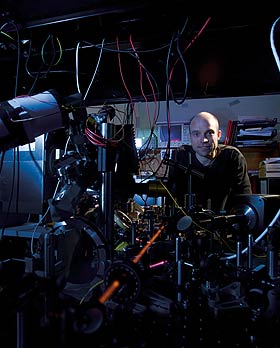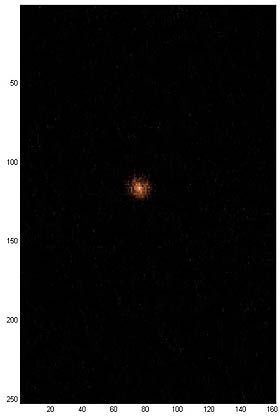
 Dr Mikkel Andersen:
Dr Mikkel Andersen:
He and his team have been able to consistently isolate single atoms, an important step towards the world of quantum computers.
A team of University of Otago physicists have achieved an internationally significant scientific breakthrough, one that is attracting worldwide interest.
Dr Mikkel Andersen, together with Dr Tzahi Grunzweig, Dr Andrew Hilliard and Matt McGovern, have used laser-cooling technology to slow a group of rubidium 85 atoms; then, by using a laser beam, or “optical tweezers”, they have been able to isolate and capture one atom – and photograph it through a microscope. The researchers have now proved they can consistently produce individual trapped atoms – a major step towards the next-generation, ultra-fast quantum-logic computers, which harness the power of atoms to perform complex tasks.
 A single, isolated atom photographed by the Otago physicists. The numbers down the side and along the bottom of this image refer to pixels. Due to the magnification of the microscope used, each pixel corresponds to 361nm in the plane of the atom.
A single, isolated atom photographed by the Otago physicists. The numbers down the side and along the bottom of this image refer to pixels. Due to the magnification of the microscope used, each pixel corresponds to 361nm in the plane of the atom.
Andersen says that, unlike conventional silicon-based computers which generally perform one task at a time, quantum computers have the potential to perform numerous long and difficult calculations simultaneously.
“Our method provides a way to deliver the atoms needed to build this type of computer,” he says.
“It has been the dream of scientists for the past century to see into the quantum world. What we have done moves the scientific frontier and gives us control of the smallest building blocks in our world.” Atoms are so small that 10 billion side by side would stretch only one metre in length. They also move at the speed of sound which makes them extremely difficult to manipulate and capture.
Andersen says that within three weeks of first trapping the atom, experiments previously not thought possible were already underway. The next step is to try to generate a “state of entanglement” between the atoms, a kind of “atomic romance” which lasts the distance.
“We need to generate communication between the atoms where they can feel each other so, when they are apart, they stay entangled and don't forget each other, even from a distance. This is the property that a quantum computer uses to do tasks simultaneously.”
Andersen says that for him, personally, the breakthrough has been a major milestone.
“I learnt at elementary school that it is impossible to see a single atom through a microscope. Well, my elementary school teacher was wrong.”
Funding

- Foundation for Research, Science and Technology
- University of Otago Research Grant